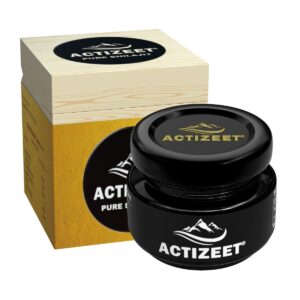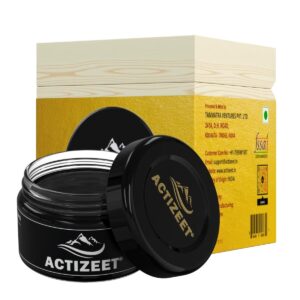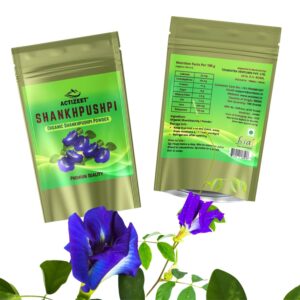Shilajit, derived from Sanskrit meaning “conqueror of mountains and destroyer of weakness,” is a unique substance that holds immense importance in traditional Ayurvedic medicine. This dark, resinous exudate oozes from the cracks and crevices of mountainous regions, particularly the mighty Himalayas.
Composed of a complex blend of organic matter and minerals, shilajit is revered for its rejuvenating properties and is aptly referred to as the “elixir of life.” It is believed to enhance vitality, promote longevity, boost cognitive function, strengthen the immune system, and improve overall well-being. Such remarkable attributes have captivated scientists and health enthusiasts alike, leading to increased interest in understanding the proper methods for extracting this treasured substance.
Table of Contents
ToggleImportance of proper extraction methods
The significance of employing correct extraction techniques cannot be overstated when it comes to shilajit. The intricate process involves skilful handling to preserve the integrity and potency of this precious gift from nature. Improper extraction can lead to contamination or degradation of its valuable components, thereby diminishing its therapeutic potential.
By utilizing appropriate methods, we not only ensure purity and authenticity but also unlock the full range of bioactive compounds present in shilajit. Fueled by a genuine desire to harness this natural wonder responsibly, experts strive to develop sustainable practices that respect both the environment that provides us with shilajit and those communities who rely on it for their livelihoods.
Formation and Availability of Shilajit
Geological Origins and Composition
Shilajit, a remarkable substance with profound health benefits, has its origins deeply rooted in the geological processes that shape our planet. This resinous substance is formed over centuries through the decomposition of plant matter under high pressure and temperature conditions. It is a rich amalgamation of organic compounds and minerals, making it a veritable treasure trove for human wellness.
The composition of shilajit varies depending on its source, but it typically contains fulvic acid, humic acid, vitamins, minerals, amino acids, and other biologically active substances. These unique components contribute to the therapeutic properties that have fascinated scholars and healers for centuries.
Natural Habitats and Regions Where It Is Found
Shilajit is found in specific regions around the world known for their geological characteristics conducive to its formation. The Altai Mountains in Central Asia are renowned for their abundant shilajit deposits, which seep out from rocks nestled within pristine forests. In the Himalayas, from Nepal to Bhutan and beyond, shilajit can be found at high altitudes where the earth’s tectonic forces have shaped majestic peaks over millions of years.
The Caucasus Mountains in Eurasia also harbour valuable sources of this resinous gem. Additionally, other areas such as Siberia, Tibet, and Afghanistan’s Hindu Kush range, as well as parts of South America also possess natural habitats that foster shilajit formation.
These regions benefit from unique climatic conditions that contribute to the exceptional quality of shilajit extracted from these locations. By understanding the geological origins and composition of shilajit along with its natural habitats and regions where it can be found, we gain insight into just how extraordinary this substance truly is.
Its formation process spanning centuries and its association with specific geographical conditions make it a truly remarkable gift from nature. In the next sections, we will explore the traditional and modern methods employed to extract this valuable substance and the importance of proper extraction techniques to preserve its potency.
Traditional Methods of Shilajit Extraction
Collection from rock crevices and cliffs
In the traditional methods of extracting shilajit, collectors brave the rugged and treacherous terrains where this precious substance can be found. They carefully navigate through steep mountainsides, searching for rock crevices and cliffs where shilajit oozes out. Equipped with the knowledge passed down through generations, they skillfully scrape off the resin-like substance with special tools.
The process demands patience and agility as they manoeuvre their way around narrow pathways to access these elusive deposits. As they collect shilajit, they take care not to disturb the delicate ecosystem surrounding these natural formations, ensuring minimal impact on the environment.
Sun drying and purification techniques
After collecting shilajit resin from the rock crevices and cliffs, traditional methods employ a process of sun drying to purify it further. The collected resin is spread out on clean mats or flat surfaces in direct sunlight, allowing it to dry naturally under the warm rays of the sun.
This exposure promotes evaporation of any remaining moisture present in the resin, resulting in a more concentrated form of shilajit. This age-old technique not only helps remove impurities but also enhances its potency.
Once dried, further purification techniques are applied to eliminate any remaining impurities or foreign particles that may have adhered to the resin during collection or drying. These purification methods include meticulous sieving using fine mesh or cloth filters that effectively separate debris and unwanted materials from the desired extract.
This ensures that only pure and high-quality shilajit remains for use. Traditional methods of extracting shilajit involve intrepid collectors venturing into mountainous regions to collect resin from rock crevices and cliffs.
Then these collectors carefully dry this resin under sunlight while taking measures to remove impurities through purification techniques. These age-old practices not only preserve the integrity and potency of shilajit but also showcase the deep connection between humans and nature in their quest for this precious substance.
Modern Techniques for Shilajit Extraction
Identification of potential sources through geological surveys
When it comes to extracting shilajit using modern techniques, one of the first steps is identifying potential sources through thorough geological surveys. Geologists and experts in the field conduct extensive research to pinpoint areas where shilajit formation is likely to occur.
This involves analyzing the geological composition, studying rock formations, and assessing the presence of organic matter that contributes to its formation. By understanding the specific conditions and regions where shilajit is more likely to be found, extraction efforts can be focused on these locations.
Excavation and collection using specialized tools and equipment
Once potential sources have been identified, it’s time for excavation and collection. Specialized tools and equipment are utilized during this phase to ensure efficient extraction without compromising the quality of the shilajit. Excavation techniques such as rock blasting or manual digging are employed depending on the accessibility of the site.
Careful attention is given to minimize contamination or damage during this process. Advanced equipment like excavators or hydraulic systems may be used in larger-scale operations while smaller-scale collectors rely on hand tools like chisels, hammers, or even brushes for delicate removal from rock crevices.
With these modern techniques at hand, extracting shilajit has become a more strategic endeavour that combines scientific knowledge with practical expertise. The identification of potential sources through geological surveys helps concentrate efforts in areas most likely to yield high-quality shilajit while excavation methods ensure a careful collection process that maintains its integrity throughout extraction.
Purification Process for Shilajit Extracts
Removal of Impurities through Filtration Methods
When it comes to extracting shilajit, one crucial step is purifying the extracted resin to ensure its quality and potency. Filtration plays a vital role in this purification process, helping remove impurities that might have found their way into the resin during extraction. The filtration methods used are simple yet effective in separating solid particles from the desired shilajit extract.
Sedimentation Process to Separate Solid Particles
One commonly employed technique in the purification of shilajit extracts is sedimentation. This process allows for the settling of heavier solid particles that may have been suspended in the raw extract.
After collection, the extract is left undisturbed for a period of time, allowing gravity to facilitate the sinking of these unwanted particles to the bottom. This sedimentation stage ensures that only clear and purified shilajit extract remains for further processing.
Filtration Using Fine Mesh or Cloth to Eliminate Debris
Once sedimentation has taken place, we move on to an additional filtration step using fine mesh or cloth material. This filtration method aids in separating any remaining debris or smaller solid particles from the liquid portion of the shilajit extract.
The mesh or cloth acts as a sieve, catching these impurities as they pass through while allowing the purified extract to flow through unobstructed. This meticulous process ensures a cleaner and more refined final product.
Through a careful purification process involving both sedimentation and filtration techniques, shilajit extracts undergo thorough cleansing from unwanted impurities and solid particles. These steps contribute significantly towards maintaining high-quality standards and ensuring that only pure shilajit resin is obtained for consumption and use.
Laboratory Analysis and Quality Control Measures
Testing for Purity, Authenticity, and Potency
When it comes to shilajit extraction, ensuring the purity, authenticity, and potency of the final product is of utmost importance. To achieve this, rigorous testing procedures are conducted in specialized laboratories.
These tests aim to verify that the extracted shilajit meets the required standards and is free from contaminants or adulterations. The purity test involves assessing the presence of any impurities that may have been introduced during the extraction process.
Authenticity testing ensures that the product indeed contains genuine shilajit and has not been substituted with inferior substances. Additionally, potency assessment measures the concentration of key active compounds present in shilajit.
Proximate Analysis to Determine Major Constituents
The proximate analysis provides valuable insights into the major constituents present in shilajit extracts. This analysis helps researchers determine essential components such as minerals, vitamins, amino acids, lipids, and organic compounds found within shilajit.
By quantifying these constituents accurately through laboratory techniques like spectroscopy or chromatography, scientists can better understand their nutritional value and potential health benefits. The proximate analysis also aids in establishing quality control parameters for different batches of shilajit products to ensure consistency.
Chemical Profiling using Advanced Analytical Techniques
In addition to proximate analysis, advanced analytical techniques are employed for comprehensive chemical profiling of shilajit extracts. These techniques include gas chromatography-mass spectrometry (GC-MS), liquid chromatography-mass spectrometry (LC-MS), nuclear magnetic resonance (NMR), and infrared spectroscopy (IR).
Through these methods, scientists can identify specific compounds present in shilajit at a molecular level. This detailed chemical profiling contributes to understanding the complex composition of shilajit and aids in identifying bioactive compounds responsible for its therapeutic properties.
This knowledge is crucial for quality control and standardization of shilajit extracts, ensuring that consumers receive products with consistent and desired chemical profiles. By employing laboratory analysis and quality control measures, we can confidently ascertain the purity, authenticity, and potency of shilajit extracts.
Proximate analysis helps us understand the major constituents present in shilajit while chemical profiling utilizing advanced analytical techniques provides deeper insights into its complex composition. These scientific methods not only ensure that consumers receive high-quality shilajit products but also contribute to ongoing research regarding the health benefits of this remarkable natural substance.
Ethical Considerations in Shilajit Extraction
Sustainable Harvesting Practices to Ensure Long-Term Availability
When it comes to extracting shilajit, sustainability is key. It is essential to ensure that the harvesting practices do not harm the natural habitats where shilajit is found. Responsible collectors adhere to strict guidelines to prevent over-harvesting or damaging the surrounding ecosystems.
They carefully select only mature shilajit, allowing younger deposits time to replenish and grow. By employing sustainable harvesting practices, we can safeguard the long-term availability of this valuable substance for future generations.
Promoting Fair Trade Practices with Local Communities
Another crucial aspect of ethical shilajit extraction is promoting fair trade practices with local communities. Many regions where shilajit is sourced are inhabited by indigenous populations who have been traditionally involved in its collection for centuries.
To ensure their welfare and empowerment, it is vital that fair compensation is provided for their contributions. By establishing fair trade agreements, we can support these communities economically, enhancing their livelihoods while also preserving their cultural heritage tied to shilajit extraction.
Ethical considerations in shilajit extraction extend beyond just preserving the environment but also encompass supporting local communities and ensuring a sustainable future for this precious substance. By practising sustainable harvesting techniques and promoting fair trade agreements with indigenous groups, we can protect both the ecological balance and socio-economic well-being associated with shilajit extraction.
Storage, Packaging, and Transportation of Shilajit Extracts
Proper storage conditions to maintain quality over time
When it comes to storing shilajit extracts, providing the right environment is paramount. You don’t want to compromise the integrity and potency of this precious substance. The ideal storage conditions for shilajit involve keeping it away from direct sunlight, excessive heat, and moisture.
Sunlight and heat can accelerate the degradation process, leading to a loss of its beneficial properties. Therefore, finding a cool, dark place like a cupboard or pantry is essential to ensure the longevity of your shilajit extract.
Avoiding exposure to sunlight, heat, or moisture
Shilajit is sensitive to sunlight as its active compounds can be easily damaged by UV rays. To shield it from these harmful rays, store your shilajit extract in opaque containers or wrap it with a protective covering.
Additionally, extreme temperatures can alter its composition and diminish its potency. Hence, it’s crucial to avoid keeping it near heat sources like stovetops or radiators.
Moreover, moisture can invite microbial growth and affect the product’s quality. So make sure your storage area is dry with low humidity levels.
Use of airtight containers to prevent oxidation
Oxidation is an enemy that can deteriorate the quality of any organic substance over time – including shilajit extract. To keep oxidation at bay and preserve its potent properties for as long as possible, use airtight containers for storage. These containers create a barrier against air exposure that could potentially trigger oxidation reactions within the extract’s molecular structure.
Safe packaging materials for preserving the integrity of the product
The packaging material plays an integral role in safeguarding the integrity of shilajit extracts during storage and transport. High-quality packaging materials such as glass jars or metal tins are popular choices due to their non-reactive nature that prevents any chemical interaction with the product.
Moreover, these materials offer excellent protection from temperature fluctuations and UV radiation. Ensure that the lids or caps fit tightly to prevent any air leakage, moisture intrusion, or accidental spillage.
Logistics considerations for safe transportation
Transporting shilajit extracts safely requires careful planning and attention to detail. The first step is to select a reliable shipping service that understands the delicate nature of this valuable substance.
Proper cushioning and insulation should be used within the shipping packages to protect against external impacts during transit. Additionally, labelling the package as “fragile” can help ensure careful handling by logistics providers.
Storing shilajit extracts properly is crucial for maintaining their quality over time. Protect them from sunlight, heat, and moisture by finding a cool, dark place for storage.
Use airtight containers made of glass or metal to prevent oxidation and choose safe packaging materials that preserve their integrity. When transporting shilajit extracts, opt for reliable shipping services and provide adequate cushioning for protection.
Conclusion: The Art
Mastery Through Extraction
Extracting shilajit is truly an art form, requiring a delicate balance of knowledge, skill, and patience. From the traditional methods passed down through generations to the modern techniques employed today, it is evident that extracting this precious substance is not a task for the faint-hearted.
The expertise required to identify potential sources, excavate them with precision, purify the extract meticulously, and analyze its quality is nothing short of remarkable. Each step in the process demands attention to detail and an unwavering commitment to excellence.
Preserving Nature’s Bounty
While shilajit extraction may seem like a mysterious endeavor, it is crucial to approach it ethically and sustainably. The future availability of this remarkable substance relies heavily on responsible harvesting practices. By adhering to principles of fair trade and promoting conservation efforts in local communities where shilajit is found, we can ensure that nature’s bountiful gifts are protected for generations to come.
A Promising Journey Ahead
As we delve deeper into understanding the potential benefits of shilajit for human health and well-being, there is an air of excitement surrounding its extraction process. The evolution from ancient collection methods to modern scientific techniques has opened up new possibilities for unlocking the full potential of this enigmatic substance. With ongoing research aimed at unravelling its chemical complexities and innovative approaches in extraction and purification processes, we stand on the precipice of discovering even more about Shilajit’s hidden wonders.
Extracting shilajit is an intricate affair that blends tradition with innovation. It requires expertise honed over centuries along with cutting-edge scientific advancements.
As we strive towards sustainable practices that preserve our natural resources while maximizing their benefits for humanity, there is optimism in uncovering more about this magnificent gift from the Earth. So, let us continue on this journey, with reverence for the art of shilajit extraction, and an unwavering belief in the wonders that lie within.
The Purest form of Shilajit
-
Himalayan Shilajit, Pure shilajit, Shilajit, SHUDDH SURYA TAPI SHILAJIT
Rated 4.74 out of 5₹4,950.00Original price was: ₹4,950.00.₹3,950.00Current price is: ₹3,950.00. Incl. GST ADD TO CARTBuy Now -
Himalayan Shilajit, Pure shilajit, Shilajit, SHUDDH SURYA TAPI SHILAJIT
Rated 4.78 out of 5₹9,900.00Original price was: ₹9,900.00.₹6,450.00Current price is: ₹6,450.00. Incl. GST ADD TO CARTBuy Now -
Himalayan Shilajit, Pure shilajit, Shilajit, SHUDDH SURYA TAPI SHILAJIT
Rated 4.74 out of 5₹3,450.00Original price was: ₹3,450.00.₹2,450.00Current price is: ₹2,450.00. Incl. GST ADD TO CARTBuy Now -
Himalayan Shilajit, Pure shilajit, Shilajit, SHUDDH SURYA TAPI SHILAJIT
Rated 4.81 out of 5₹8,400.00Original price was: ₹8,400.00.₹5,450.00Current price is: ₹5,450.00. Incl. GST ADD TO CARTBuy Now
POPULAR PRODUCT CATEGORIES
Related posts:
- Unveiling the Purest Shilajit Brand: Discover Which Brand Reigns Pure
- Unveiling the Mystery: When Does Shilajit Expire? | Expert Insights
- Unveiling the Purest Shilajit: Uncover Which Shilajit is Pure
- Unveiling the Best Shilajit: Discovering Which Shilajit is Good
- Unveiling the Best Shilajit: Which Brand Reigns Supreme?
- Unveiling the Truth: Is Shilajit Natural? Find Out Now!
- Unlocking the Mysteries: Unveiling Why Actizeet Shilajit Commands a Premium Price
- Unveiling the Best Shilajit in India: Your Ultimate Guide











